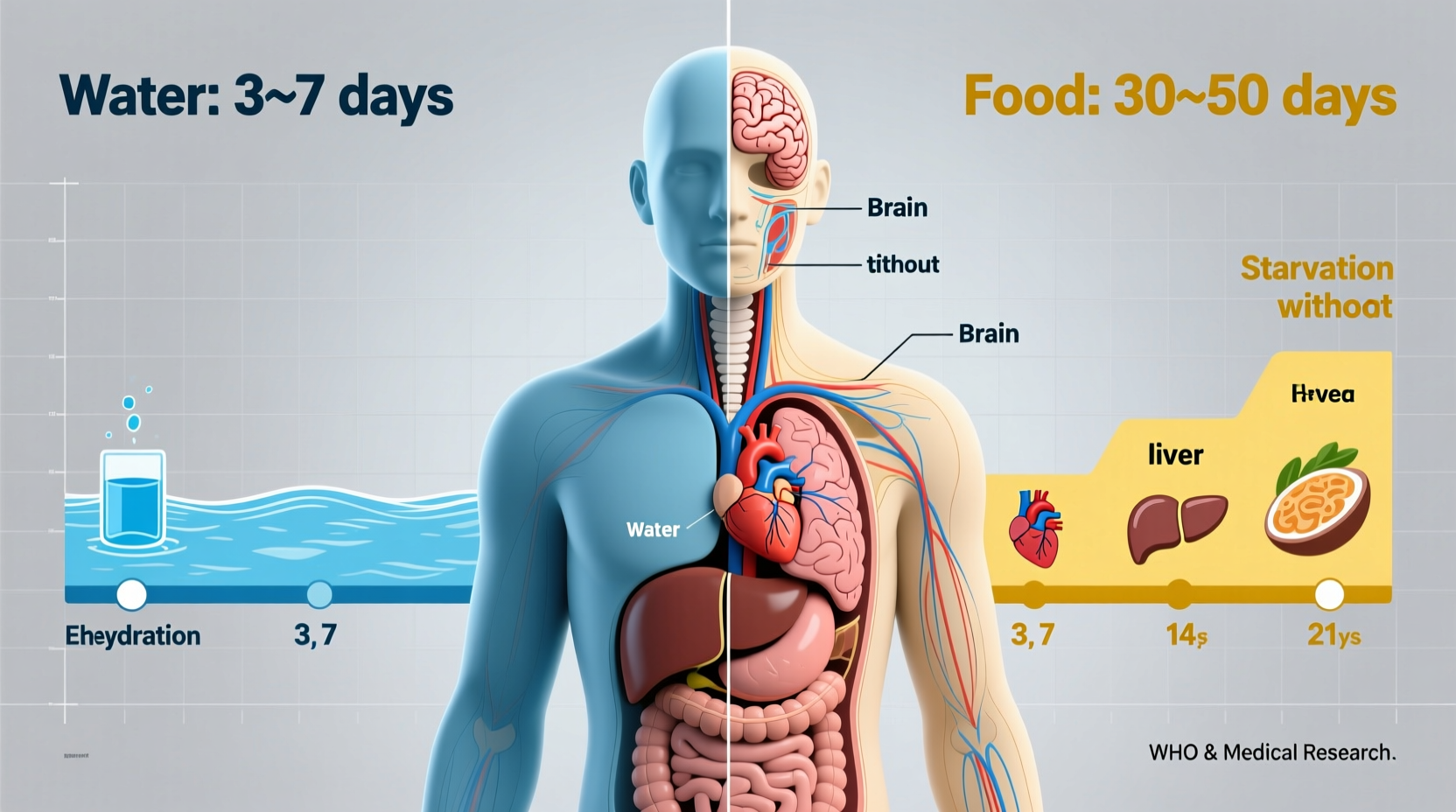Understanding human survival limits isn't just theoretical knowledge—it's critical information that could save your life or someone else's during emergencies. Whether you're preparing for outdoor adventures, concerned about disaster readiness, or simply curious about human physiology, knowing the realistic timelines and warning signs of dehydration and starvation provides essential context for making informed decisions.
The Science Behind Survival Timelines
When your body lacks essential resources, it initiates complex physiological processes to prolong survival. Water represents your most immediate vulnerability because it's involved in nearly every bodily function—from temperature regulation to waste elimination. Without adequate hydration, your blood volume decreases, forcing your heart to work harder while reducing oxygen delivery to vital organs.
Food deprivation follows a different pattern. Your body initially uses stored glycogen (typically depleted within 24-48 hours), then transitions to fat metabolism, and finally begins breaking down muscle tissue. This metabolic shift explains why individuals with higher body fat percentages often survive longer without food.
| Resource Deprivation | Typical Survival Time | Critical Threshold | Primary Physiological Impact |
|---|---|---|---|
| Complete water deprivation | 3-4 days | 10% body weight loss | Organ failure, circulatory collapse |
| Complete food deprivation | 3 weeks | Body mass index (BMI) below 13 | Metabolic shutdown, cardiac complications |
| Water only (no food) | 4-8 weeks | Severe protein deficiency | Organ deterioration, weakened immunity |
How Environmental Factors Alter Survival Odds
Temperature dramatically impacts your survival timeline. In hot environments (above 90°F/32°C), dehydration accelerates as your body loses approximately 1-2 liters of fluid per hour through sweating. The Mayo Clinic documents cases where healthy adults developed severe dehydration within 24 hours during heatwaves (Mayo Clinic, 2023).
Cold environments present different challenges. While you might retain fluids longer in cooler temperatures, hypothermia increases caloric demands. Your body burns additional energy to maintain core temperature, potentially accelerating starvation effects. The Centers for Disease Control and Prevention (CDC) reports that survival time without food decreases by 25-30% in freezing conditions compared to temperate environments (CDC, 2024).

Day-by-Day Physiological Breakdown
Water deprivation progression:
- Day 1: Mild thirst, reduced urine output, initial fatigue
- Day 2: Significant thirst, dry mouth, headache, reduced cognitive function
- Day 3: Severe dehydration symptoms—dizziness, rapid heartbeat, minimal urine production
- Day 4: Organ failure begins, confusion, loss of consciousness
Food deprivation progression:
- Days 1-3: Glycogen depletion, hunger pangs, initial energy drop
- Days 4-7: Ketosis begins, reduced hunger, mental clarity ("starvation high")
- Weeks 2-3: Muscle wasting, weakened immunity, organ stress
- Week 4+: Critical organ deterioration, high mortality risk
Individual Factors That Change the Equation
Your personal survival window depends on multiple physiological variables. Age significantly impacts outcomes—children and elderly individuals typically survive shorter periods due to less physiological reserve. A 2022 study published in the Journal of Emergency Medicine found children dehydrate 50% faster than adults in identical conditions (Journal of Emergency Medicine, 2022).
Pre-existing health conditions dramatically alter survival timelines. Individuals with diabetes experience accelerated dehydration due to frequent urination. Those with kidney disorders face compounded risks as their bodies struggle to regulate fluid balance. Even fitness level matters—athletes with higher muscle mass require more water but may have better physiological resilience during food deprivation.
Documented Survival Cases: What Real Evidence Shows
The longest documented survival without food comes from the 1981 Irish hunger strikes, where Bobby Sands lived 66 days with only water. This exceptional case involved careful medical monitoring and gradual starvation under controlled conditions—far different from typical emergency scenarios.
For water deprivation, the Guinness World Records documents a 18-day survival with minimal water intake during the 2003 California wildfires. However, this case involved intermittent access to small water quantities, not complete deprivation. Complete water deprivation cases exceeding 4 days are exceptionally rare and typically involve extraordinary circumstances or measurement errors.
Practical Emergency Guidance: What to Do
If you find yourself in a situation with limited resources, prioritize water conservation. Avoid physical exertion during peak heat hours, seek shade, and breathe through your nose to reduce moisture loss. The American Red Cross emphasizes that even small amounts of water (2-4 ounces hourly) significantly extend survival time compared to complete deprivation (American Red Cross, 2023).
When food becomes scarce, focus on preserving energy. Your body enters conservation mode after 48 hours without food, but unnecessary movement accelerates metabolic demands. In survival situations, the World Health Organization recommends prioritizing water purification over food gathering, as contaminated water poses immediate life-threatening risks (WHO, 2024).
When to Seek Immediate Medical Attention
Recognize these critical warning signs that require urgent intervention:
- No urine output for 12+ hours (severe dehydration)
- Inability to keep fluids down for 24 hours
- Confusion or disorientation
- Rapid heartbeat with minimal exertion
- Extreme weakness preventing movement
Emergency medical professionals treat severe dehydration with intravenous fluids and electrolyte replacement. For prolonged starvation, refeeding syndrome represents a significant risk—medical supervision is essential when reintroducing nutrition after extended deprivation.











 浙公网安备
33010002000092号
浙公网安备
33010002000092号 浙B2-20120091-4
浙B2-20120091-4